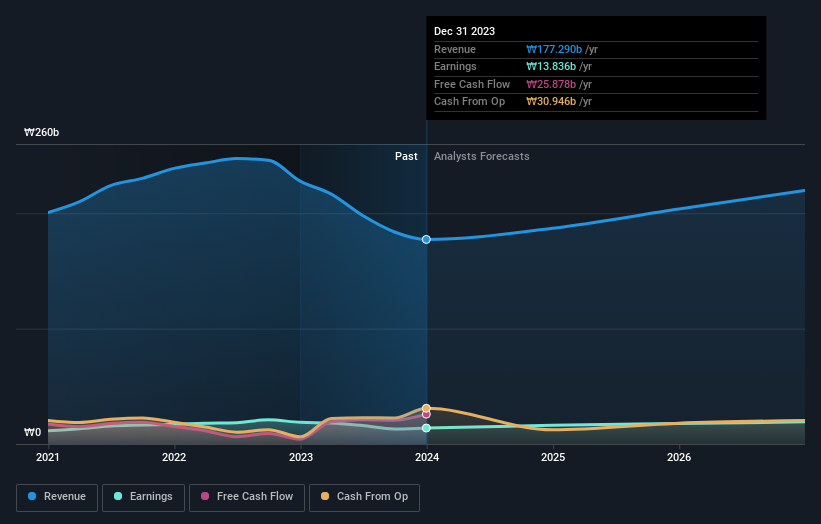Stock Analysis
- South Korea
- /
- Electronic Equipment and Components
- /
- KOSE:A005680
Investors more bullish on Samyoung Electronics (KRX:005680) this week as stock rallies 14%, despite earnings trending downwards over past year

The simplest way to invest in stocks is to buy exchange traded funds. But investors can boost returns by picking market-beating companies to own shares in. For example, the Samyoung Electronics Co., Ltd (KRX:005680) share price is up 16% in the last 1 year, clearly besting the market return of around 6.7% (not including dividends). So that should have shareholders smiling. In contrast, the longer term returns are negative, since the share price is 12% lower than it was three years ago.
After a strong gain in the past week, it's worth seeing if longer term returns have been driven by improving fundamentals.
See our latest analysis for Samyoung Electronics
To quote Buffett, 'Ships will sail around the world but the Flat Earth Society will flourish. There will continue to be wide discrepancies between price and value in the marketplace...' One flawed but reasonable way to assess how sentiment around a company has changed is to compare the earnings per share (EPS) with the share price.
During the last year, Samyoung Electronics actually saw its earnings per share drop 26%.
This means it's unlikely the market is judging the company based on earnings growth. Therefore, it seems likely that investors are putting more weight on metrics other than EPS, at the moment.
Unfortunately Samyoung Electronics' fell 22% over twelve months. So the fundamental metrics don't provide an obvious explanation for the share price gain.
The graphic below depicts how earnings and revenue have changed over time (unveil the exact values by clicking on the image).

Take a more thorough look at Samyoung Electronics' financial health with this free report on its balance sheet.
What About Dividends?
It is important to consider the total shareholder return, as well as the share price return, for any given stock. The TSR incorporates the value of any spin-offs or discounted capital raisings, along with any dividends, based on the assumption that the dividends are reinvested. Arguably, the TSR gives a more comprehensive picture of the return generated by a stock. In the case of Samyoung Electronics, it has a TSR of 20% for the last 1 year. That exceeds its share price return that we previously mentioned. This is largely a result of its dividend payments!
A Different Perspective
We're pleased to report that Samyoung Electronics shareholders have received a total shareholder return of 20% over one year. That's including the dividend. That's better than the annualised return of 0.1% over half a decade, implying that the company is doing better recently. Someone with an optimistic perspective could view the recent improvement in TSR as indicating that the business itself is getting better with time. It's always interesting to track share price performance over the longer term. But to understand Samyoung Electronics better, we need to consider many other factors. For instance, we've identified 1 warning sign for Samyoung Electronics that you should be aware of.
But note: Samyoung Electronics may not be the best stock to buy. So take a peek at this free list of interesting companies with past earnings growth (and further growth forecast).
Please note, the market returns quoted in this article reflect the market weighted average returns of stocks that currently trade on South Korean exchanges.
Valuation is complex, but we're helping make it simple.
Find out whether Samyoung Electronics is potentially over or undervalued by checking out our comprehensive analysis, which includes fair value estimates, risks and warnings, dividends, insider transactions and financial health.
View the Free AnalysisHave feedback on this article? Concerned about the content? Get in touch with us directly. Alternatively, email editorial-team (at) simplywallst.com.
This article by Simply Wall St is general in nature. We provide commentary based on historical data and analyst forecasts only using an unbiased methodology and our articles are not intended to be financial advice. It does not constitute a recommendation to buy or sell any stock, and does not take account of your objectives, or your financial situation. We aim to bring you long-term focused analysis driven by fundamental data. Note that our analysis may not factor in the latest price-sensitive company announcements or qualitative material. Simply Wall St has no position in any stocks mentioned.
About KOSE:A005680
Samyoung Electronics
Develops and sells electrolytic capacitors primarily in South Korea.
Flawless balance sheet second-rate dividend payer.


